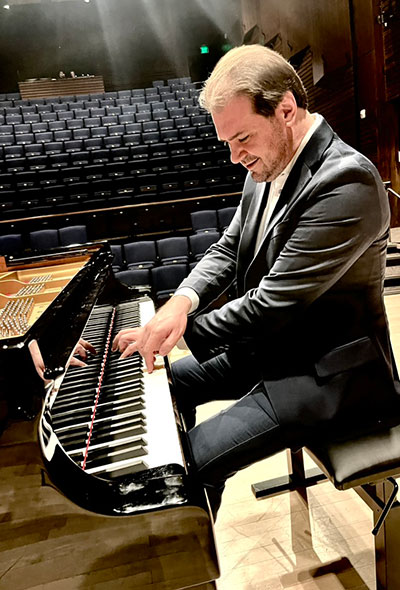
Silvan Negrutiu
The University of Wyoming Department of Music will host guest pianist Silvan Negruțiu
for a free, public recital Friday, Oct. 31, at 7:30 p.m. in the Buchanan Center for
the Performing Arts recital hall.
Negruțiu is an internationally acclaimed Romanian pianist, scholar and educator. Praised
for his “rich imagination and brilliant vigor” by The Musical News Journal, he has
performed at stages that include Carnegie Hall and the Kennedy Center and is the laureate
of numerous international competitions.
Negruțiu is the Michael and Karen Kitt Endowed Professor in Piano at Northern Arizona
University, where he also directs the Kitt School of Music’s piano studies. He is
a frequent presenter at music conferences and an advocate for innovative music pedagogy
and arts entrepreneurship, as well as the founder and artistic director of the Flagstaff
Piano Festival.
The evening’s program, titled “Kaleidoscope,” is a dynamic blend of classical cornerstones,
contemporary pieces and a selection of music by Romanian composers George Enescu and
Constantin Silvestri.
The recital opens with Enescu's “Mélodie,” the first of his “Pièces impromptues, Op.
18,” an atmospheric piece that highlights Enescu's unique expressive style. Next is
American composer Joan Tower’s powerful “Sixth Fanfare for the Uncommon Woman,” originally
commissioned for solo piano. This will be followed by Mozart’s iconic, and famously
unfinished, “Fantasia in D Minor, K. 397,” a piece noted for its free-form, improvisational
character.
The second half of the recital will explore contrasting textures and moods. The contemporary
work “Black Earth,” by Turkish pianist and composer Fazil Say, evocatively imitates
the sound of the Saz, a Turkish folk instrument, by muting the piano strings. Following
is Ludwig van Beethoven’s dramatic technical tour de force, “32 Variations in C Minor,
WoO 80.”
Two more works by Enescu follow, “Carillon nocturne, Op. 18,” which vividly evokes
bell chimes, and the serene “Sarabande, Op. 10,” which reinterprets a traditional
dance with lush harmonies and a folk-inspired style.
The recital concludes with Silvestri’s spirited “Third Piano Suite, Op. 6, No. 1,” a technically demanding Expressionist work from 1933 characterized by improvisatory melody, rhythmic audacity and diverse harmony.

